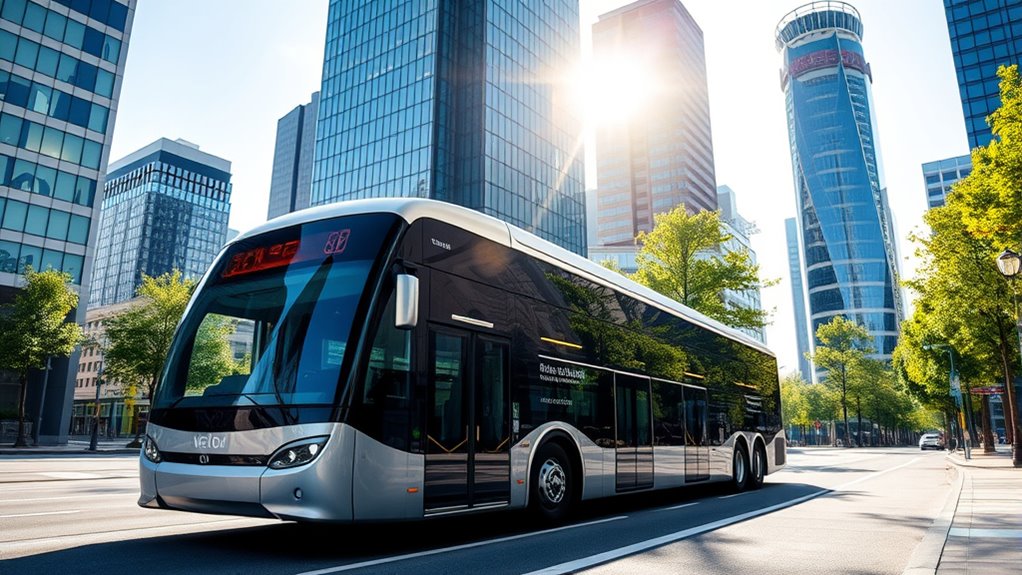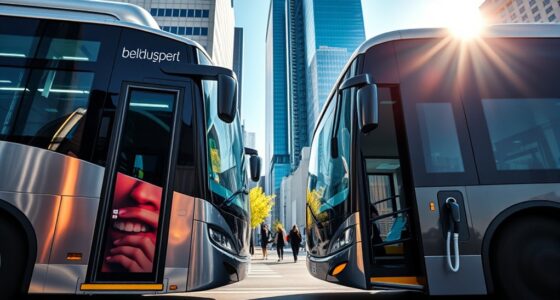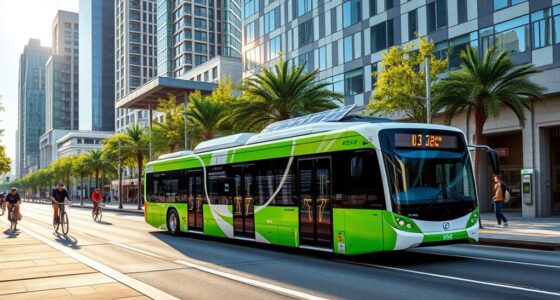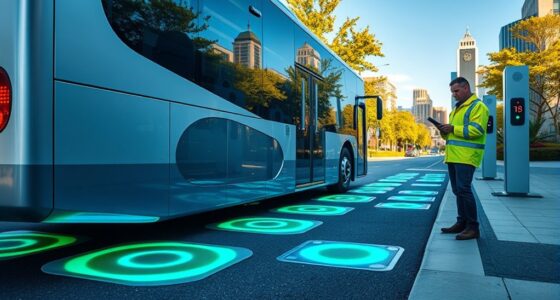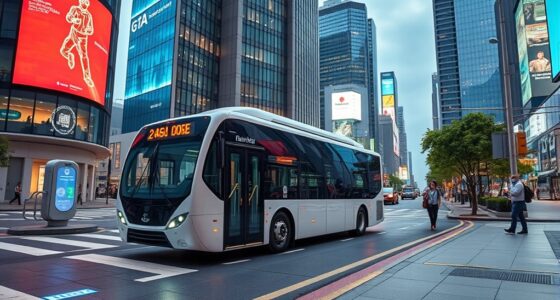Autonomous electric buses are transforming urban transit with advanced sensors like LiDAR, radar, and cameras that enable safe, real-time navigation. They offer environmental benefits by reducing emissions and noise, while their automation improves safety and efficiency. Despite challenges like infrastructure needs and high costs, pilot projects worldwide show promising progress. If you explore further, you’ll discover how technological innovations and regional efforts are shaping this exciting transportation future.
Key Takeaways
- Advanced sensors and AI enable real-time navigation and safety, making autonomous electric buses a viable urban transit solution.
- They significantly reduce emissions, noise pollution, and operational costs, promoting sustainable and efficient cities.
- Pilot projects in Gothenburg, Stockholm, and Fairfax County demonstrate growing adoption and technological advancements.
- Infrastructure investments, legal updates, and cybersecurity are essential to address safety and regulatory challenges.
- Continued innovation in battery tech and renewable energy integration will enhance environmental benefits and cost-effectiveness.
Technological Breakthroughs Powering Autonomous Electric Buses
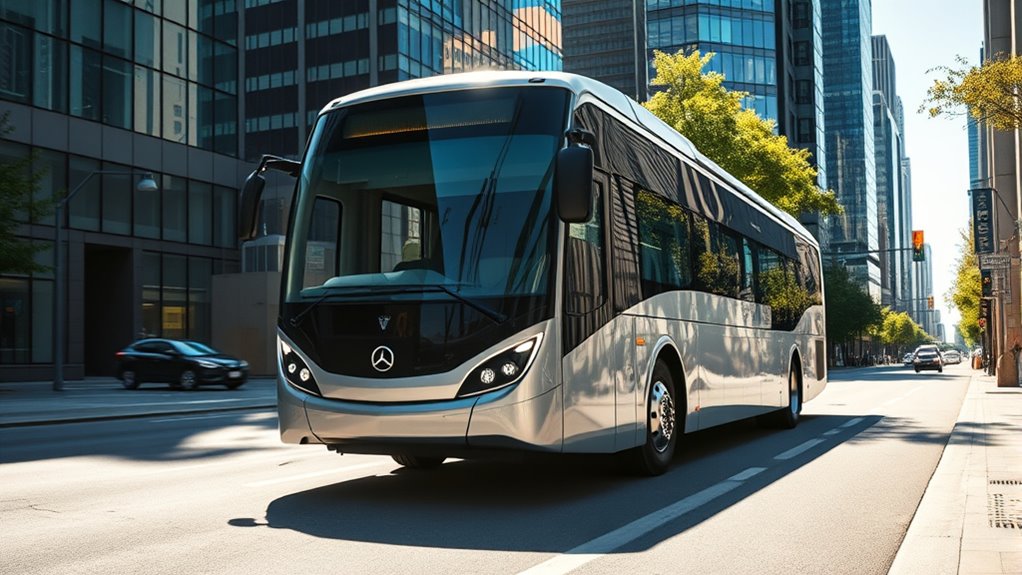
Technological breakthroughs are driving the rapid development of autonomous electric buses, making them safer and more reliable than ever. Advanced sensors like LiDAR deliver centimeter-level accuracy, detecting objects up to 120 meters away, while front radar tracks moving objects over 160 meters, even in poor weather. Cameras enhance visual data collection, providing precise navigation cues. These sensors and systems work together to environmental perception, creating a comprehensive perception of the environment that ensures safer operations. Artificial intelligence powers the self-driving capabilities, enabling real-time decision-making and improved safety. Software innovations, such as partnerships between Applied Autonomy and Adastec, refine autonomous functions and system integration. These combined technologies create a holistic detection and response system that adapts to dynamic environments. Moreover, ongoing research and regulatory support are essential to facilitate widespread adoption and ensure safety standards are met. As a result, autonomous electric buses become more capable, safer, and better suited to transform urban transit.
Advantages Transforming Urban Transit Systems
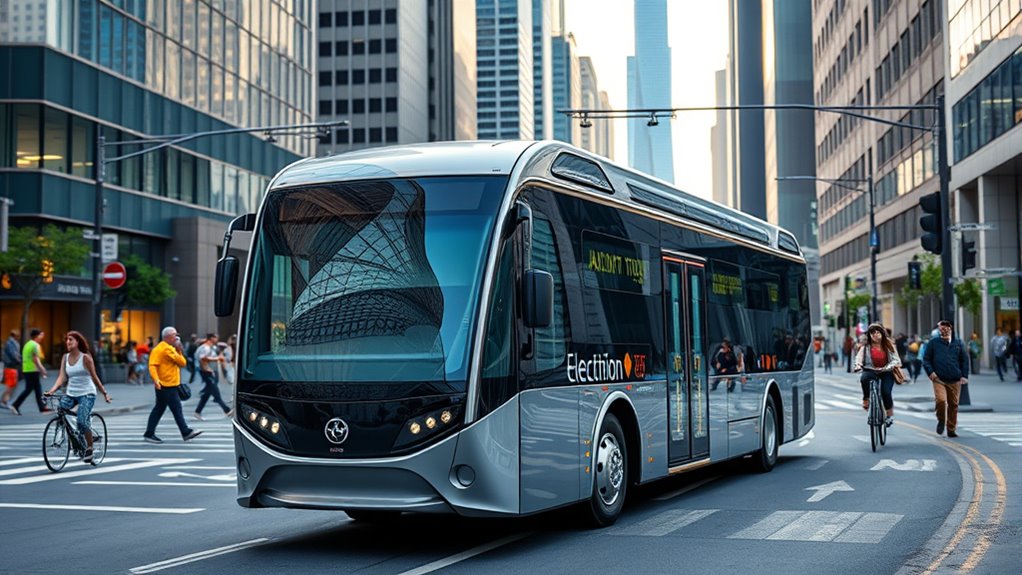
The integration of autonomous electric buses is revolutionizing urban transit by offering numerous advantages that improve efficiency, safety, and sustainability. These buses markedly reduce greenhouse gas emissions and improve air quality by eliminating tailpipe pollutants. Their quiet operation lowers noise pollution, creating healthier urban environments. By decreasing reliance on fossil fuels, especially when powered by renewable energy, cities become more sustainable. Autonomous systems optimize traffic flow, reducing energy consumption and congestion. Operationally, they run continuously, boosting efficiency, punctuality, and service reliability. Lower maintenance costs and better space utilization enhance cost-effectiveness and infrastructure use. Safety is upgraded through sensors and automation, minimizing human error and improving interactions with pedestrians and cyclists. Additionally, implementing sustainable transportation practices further enhances the environmental benefits of autonomous electric buses, aligning urban mobility with climate goals. Incorporating urban planning strategies can maximize the positive impact of these innovations on city landscapes and transit networks. Moreover, advancements in vehicle technology contribute to more adaptable and resilient transportation solutions. These advantages collectively support smarter, cleaner, and more inclusive urban transportation networks.
Challenges and Safety Considerations for Widespread Adoption
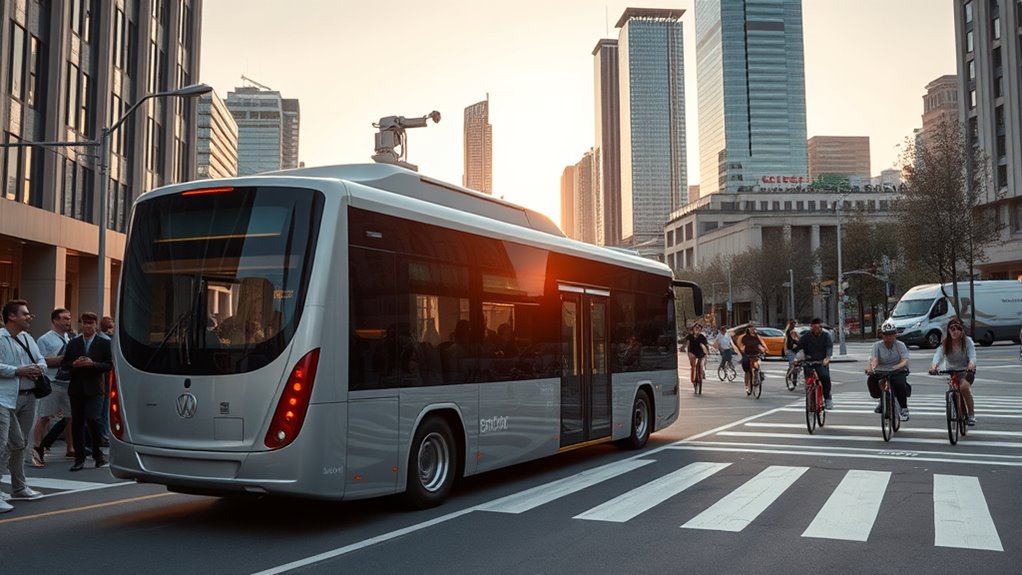
Adopting autonomous electric buses widely faces several significant challenges that must be addressed for successful integration. First, the technology is still developing, requiring further improvements to ensure safety in complex traffic scenarios.
Infrastructure is another hurdle; establishing a network of high-speed charging stations demands substantial investment.
Managing the vast data these systems generate is critical for performance and security, especially with rising cybersecurity threats. Ensuring robust cybersecurity measures is essential to prevent malicious attacks and protect passenger data.
Additionally, scaling autonomous bus networks while maintaining efficiency presents logistical challenges. The rise in cyber threats underscores the need for continuous AI security advancements to safeguard these transportation systems.
Legal issues, like defining liability, updating regulations, and ensuring passenger privacy, complicate deployment.
Financially, high upfront costs and limited access to capital hinder progress, especially for smaller operators.
Overcoming public skepticism involves building trust through safety standards, emergency procedures, and education about autonomous systems’ benefits.
Furthermore, considering AI’s role in cybersecurity, implementing robust safety measures is essential to protect these systems from malicious attacks cybersecurity measures.
Environmental and Economic Benefits Driving Change
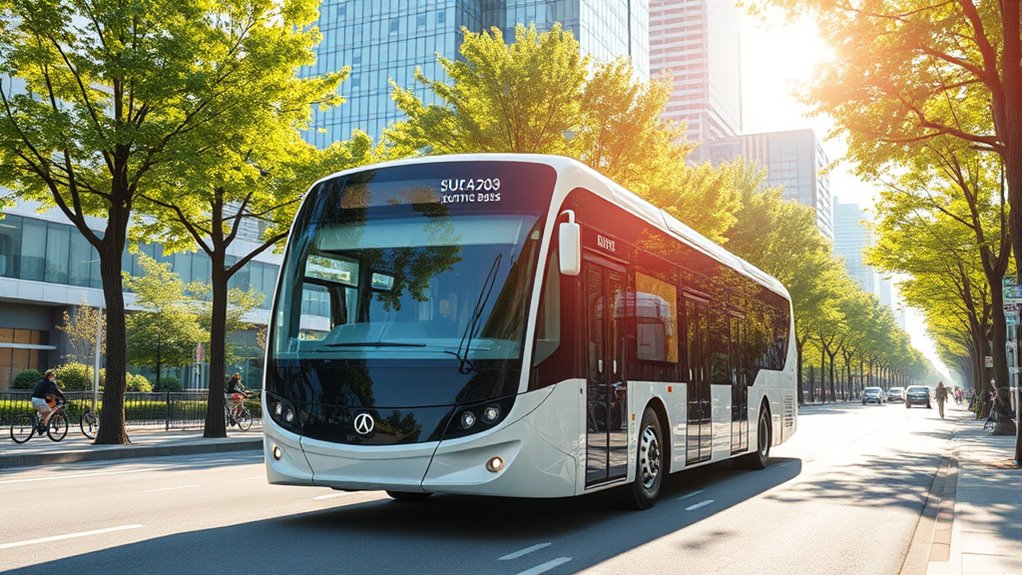
Environmental and economic benefits are powerful drivers that are accelerating the adoption of autonomous electric buses. These vehicles notably improve air quality by reducing harmful particulate matter and greenhouse gases, with each bus cutting CO2 emissions by up to 181 metric tonnes compared to diesel models. This shift can prevent thousands of premature deaths and enhance urban health.
Economically, electric buses lower operational costs by about 50%, thanks to cheaper energy and maintenance expenses. They also reduce fuel costs and generate healthcare savings of around $43,800 per bus by decreasing pollution-related health issues. Cost of Living Adjustments can play a role in long-term financial planning for transit authorities managing infrastructure investments. Additionally, implementing Ford Tuning techniques in the development of electric bus components can optimize performance and efficiency. As battery technology continues to improve, the battery lifespan of electric buses is expected to extend, further reducing costs and increasing reliability. Furthermore, advancements in battery technology are making these buses more viable and sustainable for widespread use.
Moreover, integrating renewable energy sources like solar or wind boosts sustainability. These benefits not only support environmental goals but also promote financial efficiency, making autonomous electric buses an attractive solution for cities seeking cleaner, cost-effective transportation options.
Upcoming Pilots and Future Directions in Autonomous Bus Deployment
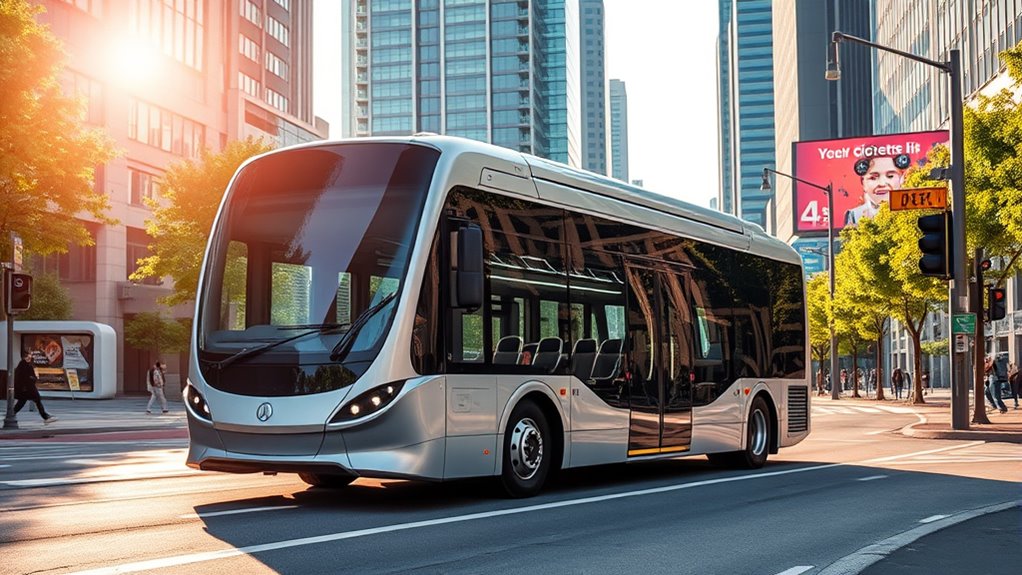
Upcoming pilot projects and technological advancements signal a promising future for autonomous bus deployment. In Gothenburg, Sweden, a new autonomous bus project using Karsan Autonomous e-Atak and advanced software will start passenger service in August 2025.
Gothenburg to launch autonomous bus service with Karsan e-Atak in August 2025.
Both Gothenburg and Stockholm are expanding electric autonomous shuttles to cut emissions and congestion. Other initiatives include the Fairfax County pilot, which recently concluded, and ongoing collaborations like Iveco and EasyMile’s prototype development. The integration of autonomous vehicles continues to drive innovation and reliability in these systems.
Companies like MAN and Karsan are pushing innovations with electric and automated designs. Regional support from governments and transport operators boosts these efforts, while investments from global manufacturers accelerate progress.
As these pilots grow, cities will refine safety measures, adapt regulations, and work to build public trust in autonomous public transport’s future.
Frequently Asked Questions
How Do Autonomous Electric Buses Handle Unexpected Obstacles on Busy Streets?
You might wonder how these buses handle unexpected obstacles on busy streets. They use advanced sensors like LiDAR and radar to detect obstacles such as pedestrians, animals, or debris.
When an obstacle appears, machine learning algorithms process the data quickly, triggering automatic braking or route adjustments.
If needed, remote control can intervene to guide the bus safely, ensuring passenger and pedestrian safety even in complex traffic situations.
What Are the Key Cybersecurity Measures Protecting Autonomous Bus Networks?
You should know that key cybersecurity measures include implementing layered protections to block threats effectively. You’d use encryption to safeguard data, multi-factor authentication to restrict access, and secure communication protocols to prevent eavesdropping.
Continuous monitoring and regular vulnerability scans help spot issues early. Additionally, adopting strict regulatory standards, conducting audits, and preparing incident response plans ensure your network stays resilient against cyber threats and maintains safety and trust.
How Will Autonomous Buses Impact Current Transit Employment Levels?
You might think autonomous buses will lead to widespread job loss, but new roles will emerge alongside this shift. As technology replaces drivers, you’ll see opportunities in fleet management, maintenance, data analysis, and infrastructure development.
While some jobs change or disappear, the progression could boost the economy, improve safety, and create a more sustainable transit system.
What Standards or Regulations Govern Autonomous Electric Bus Operations Worldwide?
You should know that worldwide, regulations for autonomous electric buses vary widely. Some regions, like Japan and South Korea, have updated laws permitting autonomous operations, while others, such as the U.S. and India, are still developing their frameworks.
International efforts aim to coordinate standards, but safety protocols like cybersecurity and remote monitoring are common. Ultimately, each area balances innovation with safety, creating a complex regulatory landscape for autonomous electric buses.
How Do Autonomous Buses Integrate With Existing Traffic Management Systems?
You might think integrating autonomous buses with traffic systems is straightforward, but it’s complex. You’ll need reliable communication links, real-time data sharing, and adaptable traffic management platforms.
These buses must sync seamlessly with signals, sensors, and existing infrastructure, often requiring upgrades.
As you navigate this integration, expect ongoing updates and collaboration across tech and transit sectors to guarantee safety, efficiency, and smooth traffic flow.
Conclusion
Imagine riding a bus that drives itself, smoothly steering busy streets like a skilled conductor guiding an orchestra. Autonomous electric buses are revolutionizing urban transit, offering cleaner air, lower costs, and safer rides. As cities pilot these innovations, you’re on the cusp of a transportation symphony where technology leads the way. Embrace this shift—it’s not just about getting from A to B, but about creating a smarter, greener future for everyone.
